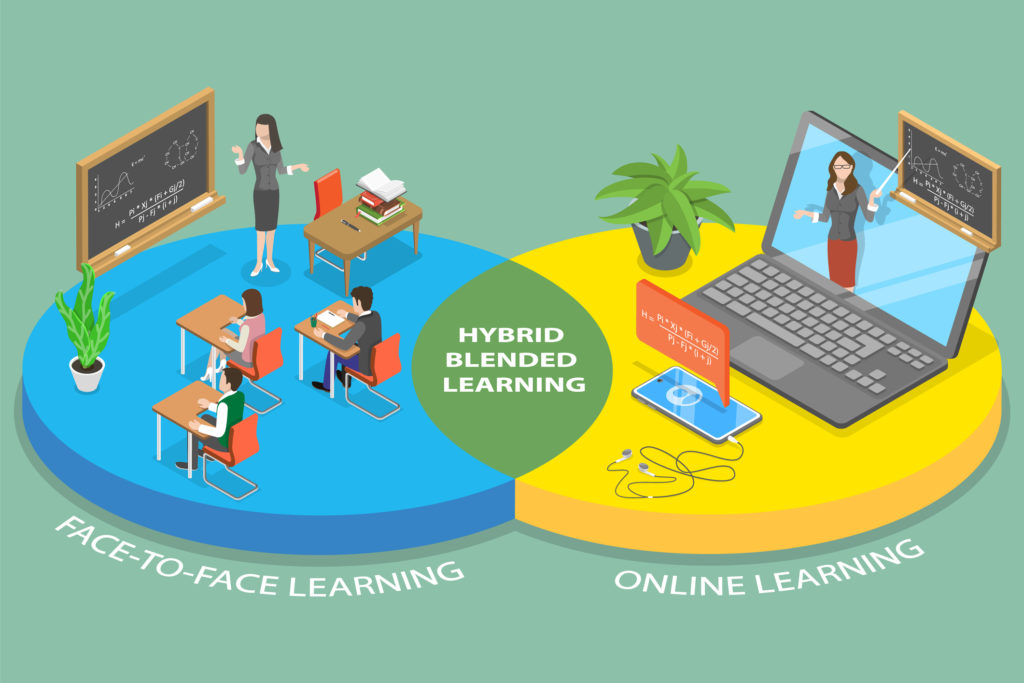Here’s something to ponder: how many acronyms are there for vocational education and training? The public would say just one: VET. But there’s always more than one way to refer to something, especially in education.
Take for example, Hybrid vs. Blended – how many of us can explain the difference between these two methods of delivery? It seems like it should be easy, but there’s always a catch with these kinds of questions. Often, organisations will use the two words interchangeably, regardless of what they’re defined as.
So, what does Hybrid delivery mean? And what does Blended delivery mean? Let’s take a look at the different terms we use in the VET Sector – and what they actually mean.
Hybrid vs. Blended: What’s what?
Hybrid, as utilised here at VDC, refers to a session that participants can attend in-person or virtually. The hybrid model of delivery is ultimately a choice, one can choose whether they want to attend in-person or virtually.
Blended delivery, however, refers to a combination of self-paced online resources and learning activities, and real-time instruction. This real-time instruction can be delivered either in-person or virtually.
The two share some obvious similarities; for example, both terms refer to a combination of in-person and virtual delivery of a topic. But that’s about the extent of the actual similarity of the two. One is a choice of how you choose to attend, the other is a method of blending virtual, self-paced learning with real-time teaching.
This confusion is likely not only created by the terms themselves, but by those who use them interchangeably. But this conundrum doesn’t begin and end with hybrid vs. blended. It’s not just course material that can end up muddled by having different ways to refer to it, it’s happened with the very sector itself.
Acronyms, acronyms, and of course, more acronyms
To get back to that first question we presented: here’s the answer.
According to the VOCEDplus Glossary, there are in fact seven different acronyms for vocational education and training – or at least something to that effect. They are as follows:
- Vocational education and training (VET)
- Technical and vocational education and training (TVET)
- Vocational and technical education and training (VTET)
- Technical and vocational education (TVE)
- Vocational and technical education (VTE)
- Further education and training (FET)
- Career and technical education (CTE).
Try saying that five-times fast!
VET isn’t the only term that’s got a doppelgänger or two, VETiS (VET in Schools) is now referred to as VETDSS (VET delivered to secondary students) or VfSSS (VET for Secondary School Students) as the program isn’t necessarily being delivered on the secondary school’s campus.
LLN (Language, literacy and numeracy), LLND (Language, literacy, numeracy and digital), and LLNP (Language, Literacy and Numeracy Program) all have striking similarities, wouldn’t you agree?
(On an almost humorous note, considering the Hybrid vs. Blended debate, VOCEDplus doesn’t yet have a definition for Hybrid in their Glossary – only Blended!)
So, what terms does VDC use?
The VET Development Centre (VDC) has very clearly defined terms – and they are as follows:
Hybrid – a session delivered concurrently online and in-person, with a choice on how you wish to attend.
Blended – real-time learning (either in-person or virtually) supported by self-paced learning between sessions.
VET Chat – 30 minute, casual session.
Webinar – 1 hour, more intensive session.
Deep Dive Webinar – 90 minute, much more intensive session on a topic – often one that requires a bit more in-depth discussion.
Virtual workshop – 3 hour, online workshop with more activities.
Half day workshop – 3 hour, in-depth workshop held at VDC, may also be offered as Hybrid delivery.
Full day workshop – 7 hour, in-depth workshop held at VDC, may also be offered as Hybrid delivery.
Why should it matter?
A standardised language for an industry is a MUST – but we can’t expect everyone to automatically know what everything means. Language evolves over time, and so too must we as an industry. So, in the end, whether you use Blended or Hybrid, just bear in mind that you may have to clarify what you mean for a while until everyone’s on the same page.








